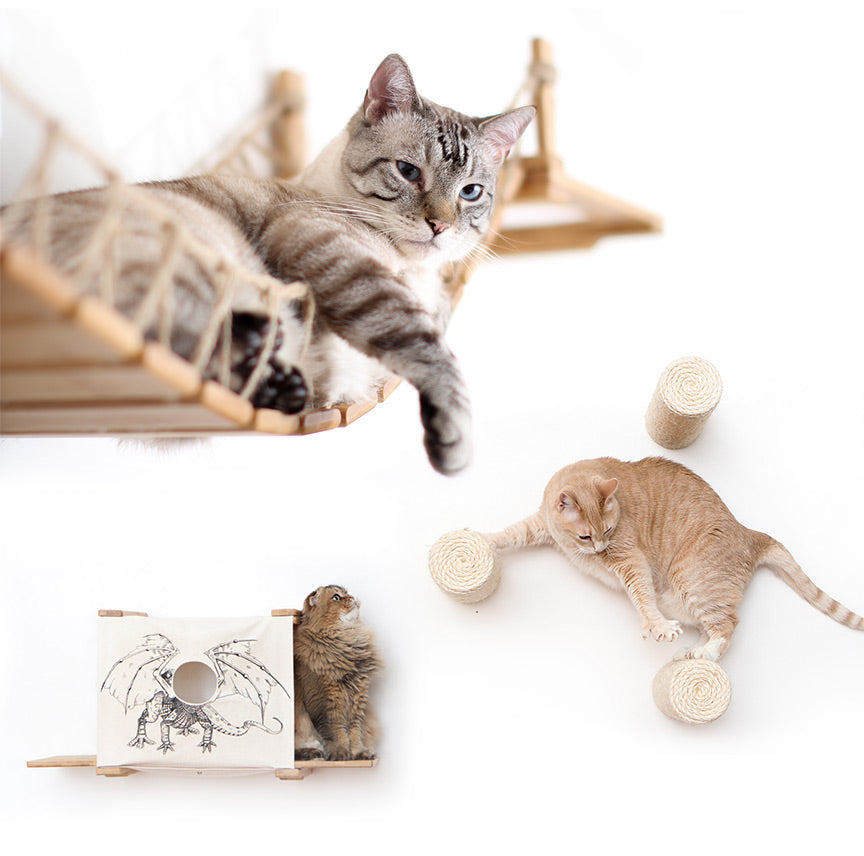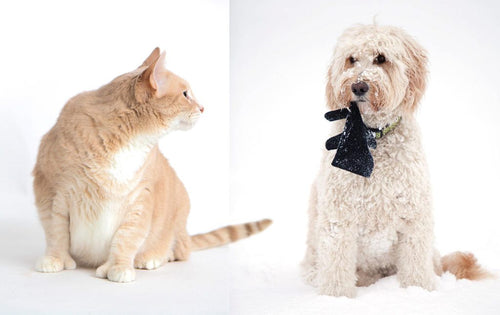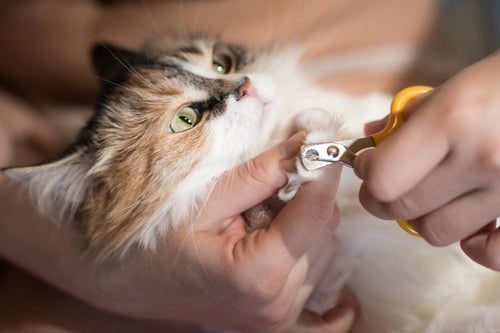Are you looking to add a canine to your already-feline-occupied household, or vice versa? Many of us enjoy the company of both species, but when integrating the two, it is important that all members of the household can do so with minimal stress, and while maximizing safety and quality of life for all. Letting your pets just “work it out” can be risky.
We also don’t want one member permanently exiled to the basement or bedroom for the rest of their lives. Instead, have a plan to integrate your pets gradually and peacefully, by setting them up for success.
In our next post, we will talk about training steps to help Whiskers and Fido become fast friends, but before that happens, you will first need to have a sound management plan in place.
WHAT IS MANAGEMENT?
Management means setting your pets up for success by arranging the environment to prevent unwanted behaviors from occurring in the first place. You are going to have a much harder training path ahead of you if your cat’s first experience of the dog is getting chased across the room, or if your dog gets welcomed with a nasty scratch across the nose. Not only does management make our training easier in the long run, it also is critical to maintaining safety.
BEFORE BRINGING THE NEW PET HOME
Your first task will be deciding how to divide the house up initially so that your current pet can get used to the new one, and so the new addition can have some time to settle in before working on introductions.

Decide where your cat’s space will be, and where your dog’s space will be well before bringing the new addition home. Initially, you should be able to block these spaces off visually, so that both pets have time to adjust before coming face-to-face, even through a barrier.
Once you have decided how you are going to divide things off initially, spend some time with your current pet getting them comfortable resting in their temporary space. If your current pet isn’t used to being confined away from you, this may be something to work on prior to adding on to the family. Set the space up to be very comfortable and interesting for your pet, and begin associating that room or rooms with special things – high-value treats, playtime, etc.

Spend time in that space with your pet, and let them have fun on their own in there as well. If your pet is still becoming highly distressed about being confined or isolated, then you may need to work with a certified behavior professional first to help resolve any separation anxiety issues.
If the current resident is feline, obviously make sure that they have access to appropriately placed litterboxes in the temporary confinement area. If litterboxes are not already in this space, introduce them now, and make sure the cat is using them in that new location.

COMING HOME
New pets will need some time to settle in and adjust to their new home, and your current pet will need to get used to the presence of another creature in their territory, so wait a couple of days before attempting introductions.
You may start to desensitize kitty to the presence of a canine by doing “scent swaps” and introducing an article of the dog’s bedding to the cat’s space. When doing this though, do not place the dog-scented item on Princess’s favorite resting space – she doesn’t want that contaminated with dog stench! Instead, set it in a more neutral area of the room, and let her investigate as she chooses.

As both pets are settling in to the new arrangement, you will then want to start very gradually increasing exposure to each other. The word “gradual” is key here – we don’t want either pet to get afraid or over-stimulated in these sessions, so again, management is key.
TO SEE OR NOT TO SEE
As mentioned, initially you will want to have solid doors in between the new pet and the existing one or have them in entirely different sections of the house.
REDUNDANCY, REDUNDANCY, REDUNDANCY
Especially in the beginning, we want to have two forms of management in place at all times. So, if Kitty is confined in the master bedroom for the first couple of days, also place a baby gate at the entrance to the hall so that Rover can’t get up to the door and start scratching and barking at it. These behaviors could be scary to your feline friend, and won’t contribute to future success.
As you start to remove physical barriers and allow the pets to see each other, we still want two pieces of physical management in place at this stage. We don’t want them to go nose to nose before they are ready, and if Fido pushes down one gate or Fluffy jumps over it, we don’t want them accidentally coming into physical contact with each other yet.
Examples could include:
- Two baby gates in a hallway spaced a few feet apart
- Having one pet on a leash AND on the other side of a gate
Make sure your cat, especially, always has the ability to leave if they have had enough.

NOW IT IS TIME TO TRAIN!
When you are ready to let the two species see each other for the first time, you still want to have a plan to make sure it goes well. Our next post will discuss how to teach both cat and dog to be comfortable and happy around each other so that you can ultimately have a peaceful, integrated household.
Remember that time and patience up front are going to get you to your goals much faster than trying to rush this process. The pay-off of having a harmonious inter-species household is worth the work up-front!
MANAGEMENT ISN'T OVER
So, canine and feline are living happily together now – does that mean the baby gates come down? Don’t be so fast to do so! Even in the most integrated households, it is still important to have some dog-free zones, both for your cat’s well-being (even the most dog-friendly cat needs some “me” time occasionally), and for managing feeding time and litter boxes.

We guarantee that your dog will think the contents of both your cat’s bowl and your cat’s box are tasty delicacies. Trust us – don’t waste time and effort trying to teach your dog not to enjoy these “snacks.” Just make sure they can’t get to them. A cat being interrupted while eating or while eliminating can also lead to problem behaviors or health issues, so make sure they have a peaceful, dog-free zone to rest, eat, and go to the bathroom in private.
CREATING A DOG-FREE ZONE
USEFUL TOOLS:
1) GATES
You can find gates in a wide variety of widths, heights, and designs. Many even are designed with a smaller cat door in the corner (a “dog filter” assuming you don’t have a toy breed), or you can sometimes modify one you have on hand already by cutting a small square big enough for your cat in it.
If yours doesn’t have a gate, and can’t be modified, you can hang it a few inches off the ground so that your cat can slip under it. Many varieties have hinges and latches, allowing you to open them up and pass through without having to climb over or remove them.
Alternately, if your cat is physically spry enough to do so safely (and your dog is not), your cat may be able to jump over the gate to solace. You might also place cat furniture or cat shelves strategically to help give them a boost over. Do not ask this of your cat though if they are older or have any physical limitations.

Make sure the gate is dog-proof. If your dog can push a pressure-mounted gate out of place, opt for a more permanent wall-mounted type. If your dog can jump it, opt for a taller version with a cat door (tips for keeping small dogs out are below).
2) CAT DOORS

Cat doors can be installed into an existing wood door to allow kitty access to their space. Check out your local pet supply store or hardware store for options.
3) CAT FURNITURE AND SHELVES
A safe space does no good if your cat can’t get there! Make sure your cat can get to their area, and can navigate the rest of the house, without unwanted attention from Fido. Cat furniture and shelves should be provided throughout the house to give them a way to get elevated, to navigate rooms without having to cross wide expanses of open floor, and to just relax without a curious dog nose in their face.

As mentioned, strategically placed, these can also allow your cat to navigate their way over a tall gate safely. If your cat is less agile, or more of a “floor-dweller,” give them some lower cat caves and hidey holes to take solace in – just make sure they don’t turn into a place where they may be cornered by a canine.
WHAT ABOUT SMALL DOGS?
If you have a toy breed that can fit through a cat-size hole or door, don’t despair – you can still keep your Chihuahua out of kitty’s domain.
A few options:
- Install a cat door that is unlocked by a small tab worn on your cat’s collar. It will unlock as Kitty approaches, and lock once they are through.
- Modify a gate to have a “cat hole,” but hang the gate upside down. So, rather than the opening being on a lower corner of the gate, it is on an upper one. This relies on your cat being athletic enough to jump through (and your dog not as skilled in their jumping technique), but most cats have dogs beat in the agility realm.
- Create an up-and-over route using furniture, shelves, etc. as discussed above.
WHAT TO AVOID
Do not be tempted to use electronic devices such as remote-activated shock collars, indoor “invisible fences,” shock-producing mats, etc. to keep Fido out. Not only are these not nearly as reliable as physical barriers, but their use can create much bigger training woes, as they can lead to fear, anxiety, and aggression. Stick to physical barriers that don’t require unpleasant, painful, or startling stimuli in order to work.
NEXT STEPS
Your short-, middle- and long-term management strategies are in place – good job! We'll talk about training in our next post!















